Why do we see spooky memes almost everywhere online today? From creepy images to glitchy jokes, these posts spread fast across the web. People share them in groups, laugh at them, or even feel a little scared.
Horror memes are pictures, videos, or jokes that mix humor with fear. They often look strange, funny, and chilling at the same time. Some of them feel like mini ghost stories, while others are just silly.
This growing meme phenomenon shows how the internet is more than just fun—it changes how people talk, share, and connect. By looking at horror memes, we can see how digital culture keeps evolving and shaping the way we spend time online.
What Are Horror Memes?
Horror memes are jokes that mix fear with fun. They look scary at first, but then you laugh. A meme can be a picture, a short video, or even a moving clip on TikTok. Some have ghost faces, others show spooky eyes, and some twist normal jokes into something strange. People often call these creepy memes because they feel both silly and chilling.
These memes did not start today. Years ago, people wrote online ghost stories called creepypasta. Others made glitch memes, where pictures looked broken or out of shape. Artists also shared surreal memes, which looked dreamy and weird. Over time, these styles mixed and shaped the horror meme culture we see now.
Why do people make them? Some do it for fun. Others want to test how much fear and humor can blend together. A scary face might get more clicks than a normal picture. A creepy laugh might make friends share it faster. Horror memes are also part of internet horror, a style where people turn digital tools into playful, eerie stories.
In short, horror memes are like mini ghost tales for the digital age. They are easy to make, quick to share, and always ready to shock or amuse.
Why Do People Like Horror Memes?
People enjoy horror memes because they mix two strong feelings: fear and laughter. When you see something scary online, your brain reacts fast. But if the scary part ends with a silly twist, you laugh with relief. This mix feels exciting.
Scientists call this the psychology of memes. It is the same reason people ride roller coasters or watch scary movies. The fear makes your heart race, and the joke gives you a safe way out. Online, this mix becomes even stronger because friends share and react together.
Compared to regular memes, horror ones feel more risky. A normal joke might make you smile. But an eerie meme can make you jump, then laugh. That’s why people call it part of eerie meme culture. It’s humor with a dark edge.
Horror memes are also a form of online humor. They allow people to laugh at the things that usually frighten them. By turning fear into a joke, the internet makes scary things less powerful.
The Connection Between Horror Memes and Digital Culture
Horror memes spread fast because the internet moves fast. A single spooky picture can jump from one group to another within minutes. When people repost it, remix it, or add new jokes, the meme becomes a cultural symbol. This is how memes grow into icons of digital culture.
But horror memes are not just jokes. They act like mirrors of our online fears. Some reflect worries about privacy, fake news, or the chaos of the digital world. Others make fun of loneliness or late-night internet habits. In this way, they are a kind of dark meme culture — humor that hides deeper thoughts.
Memes also tell stories. A single post can show fear, fun, and meaning at once. Designers call this meme aesthetics, the art of making images both simple and powerful. Horror memes often use glitch effects, ghostly filters, or broken text. These styles turn ordinary jokes into short forms of digital storytelling.
Think about money online. Just as people talk about Bitcoin to show trust in digital money, horror memes reflect trust and fear in our digital lives. Both are symbols of how the internet shapes culture.
In short, horror memes are part of a bigger web trend. They do more than make people laugh. They help us understand how fear, humor, and digital life connect.
Here’s a simple visual breakdown of how horror memes travel across the internet and shape digital culture:
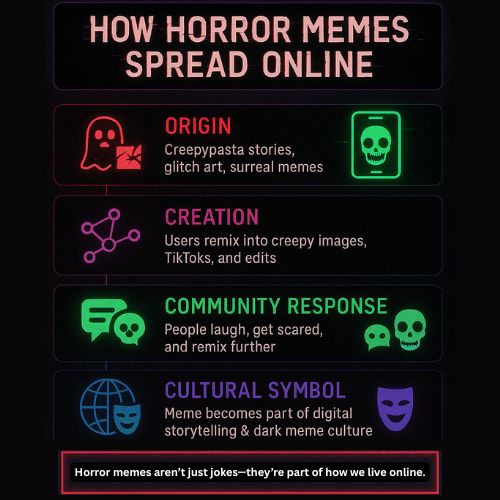
As the graphic shows, horror memes are more than quick laughs—they act as mirrors of internet culture, carrying both humor and hidden fears.
Communities Built Around Horror Memes
Horror memes are not only jokes; they are also part of meme communities. On places like Reddit, Discord, and TikTok, people gather to share these strange posts. Some groups are small, while others have thousands of fans.
Inside these online communities, people use dark jokes and secret codes. A single picture might mean nothing to outsiders, but members laugh because they know the hidden story. These are called subcultural memes, built by groups with shared humor.
Over time, these communities grow like digital clubs. Members trade memes, make new versions, and even create inside jokes that outsiders cannot understand. Horror memes act like a glue, holding these groups together through laughs and scares.
The Positive Side of Horror Memes
Horror memes are not only about fear. They can also bring good things. Many people use them as a way to relax. A funny scary post can take away stress after a long day. This makes them a part of online creativity, where fear is turned into art.
Horror memes also help people connect. Friends laugh together, even if they live far apart. These posts can build digital communities, where people bond over weird and spooky jokes.
For many creators, horror memes are a form of play. They give space to test new ideas, mix images, and show imagination. In this way, they support meme subcultures that value creativity over rules.
The oddness of these memes also makes them special. When something feels weird, people remember it better. This strangeness acts like social glue, helping people feel part of something unique.
The Risks and Harmful Sides of Horror Memes
Even though horror memes are fun, they can have risks. Some memes show disturbing pictures that may cause fear or even stress. These internet horror trends can be hard for young people to handle.
Another risk is addiction. Some people keep scrolling for hours, stuck in creepy meme trends. The mix of fear and humor keeps them hooked, but it can harm sleep or mood.
There is also the problem of unsafe sharing. Kids and teens may post memes that are too dark without knowing the danger. Some may even copy unsafe acts they see in memes. This shows why parents and teachers worry about viral horror content.
To see the balance, here’s a simple table:
| Positive Effects | Negative Effects |
| Community – brings fans together | Safety – can expose kids to harm |
| Creativity – inspires new ideas | Mental Health – may cause anxiety |
| Fun – laughter with friends | Addiction – too much scrolling |
| Stress Relief – breaks daily tension | Disturbing images – hard to forget |
Horror memes are part of subculture online, but like any trend, they have both light and dark sides.
Viral Nature of Horror Memes
Horror memes spread faster than normal memes. Why? Because they mix shock with surprise. A scary picture makes people stop, and the funny twist makes them share it. This is how they ride viral internet trends.
Platforms like TikTok and Instagram also boost them. Algorithms notice when people react fast, so they push those posts to more users. This helps horror memes grow into global internet meme evolution.
Creators also play with style. Filters, sound effects, and edits turn normal posts into horror-inspired memes that feel new. This keeps the trend fresh and exciting, making people want more.
Are Horror Memes Safe for Kids and Teens?
Kids and teens see memes every day, but horror memes can be tricky. Some posts are too dark for young minds. A sudden jump scare or creepy picture may cause fear or nightmares. This is why parents worry about this meme phenomenon.
Teachers and experts also share concerns. They say that young users may not know how to handle these jokes. What feels like fun to an adult can feel very real to a child. That’s why horror memes are part of today’s internet culture debate.
To keep kids safe, families can set limits. Here are a few simple tips:
- Watch memes together and talk about them.
- Use apps that block unsafe content.
- Set time rules so kids do not scroll all night.
In the end, horror memes are like digital ghost stories. They can be fun, but kids need guidance. With care, they can enjoy the laughs without the fear.
The Future of Horror Memes in Digital Culture
Horror memes are not slowing down. As tech grows, these memes will also change. New tools like virtual reality (VR) may let people step inside a scary joke. Artificial intelligence (AI) could create creepy memes in seconds, mixing spooky sounds and images in ways we have never seen.
In the future, memes may also become interactive. Imagine tapping a picture, and it moves with a jump scare or plays a ghostly laugh. This would turn memes into mini games, not just jokes on a screen.
Some people ask if horror memes will stay small, like a niche trend. But there is a chance they will spread even wider. Like how cryptocurrency grew from small online groups to mainstream news, horror memes may also move from subculture corners into everyday internet humor.
These spooky posts also reflect how we live in a digital subculture. They show both fear and fun in one place. As more people share them, horror memes may become a normal part of internet horror and digital life.
In the end, the future looks big for these memes. They may keep surprising us with new styles and tools, while staying funny, strange, and a little scary.
Lets Read Our Latest Article: Egress Login Tips & Secrets – Fix What Most Users Get Wrong
Conclusion
Horror memes show us how online jokes mix with fear. They started as simple posts but have grown into a big part of digital life. From creepypasta to glitch edits, these memes shape how people laugh, share, and connect online.
They bring creativity, community, and fun. At the same time, they carry risks, like addiction or scary images for kids. This balance makes them both exciting and challenging.
In short, how horror memes shape digital culture is clear. They are more than silly posts. They are small windows into how people use the internet to play with fear, humor, and imagination.
For anyone exploring online humor, horror memes remind us that digital culture is always changing. Sometimes it is silly, sometimes it is spooky — but it always reflects the world we live in.
FAQs About Horror Memes
What are horror memes?
Horror memes are online jokes that mix fear with fun. They use scary faces, eerie sounds, or strange edits, but often end with humor.
Why are horror memes popular?
People enjoy them because they feel both scary and funny. The shock makes you jump, and the laugh makes you share. This mix spreads fast in meme communities.
Can horror memes harm mental health?
Yes, if the memes are too dark, they can cause stress or fear. Some people may feel anxious after seeing creepy memes, especially kids or sensitive users.
Are horror memes safe for kids?
Not always. Some memes are too scary for children. Parents should watch together, set limits, and explain that memes are only jokes.
Do horror memes reflect real fears?
Yes. Many horror memes mirror worries about online life, loneliness, or digital chaos. They are part of a wider meme phenomenon that mixes fun with deeper meaning.
Disclaimer
This article is for informational and entertainment purposes only. Horror memes often mix humor with spooky or eerie content, which may not be suitable for all readers, especially children or sensitive individuals. Viewer discretion is advised.
Some links in this post may lead to external websites. We do not control or endorse the content of those sites and are not responsible for any issues that may arise from visiting them. Readers should use their own judgment and caution when exploring external resources.

Plankton SpongeBob Secrets: Funny, Tricky Villain & Must-See Facts

Mystery of Sagerne: Real Crimes, Legends & Unsolved Mysteries

Rowdy Oxford Integris Secrets: Discover Fun, Safety & Innovation

SkinPres T Review: Does This Anti-Aging Cream Really Work?

Joseph Quinn is a writer and digital creator best known as the founder of FreakBobTime. With years of blogging experience, he blends technology, culture, and internet humor into unique stories and creative experiments. Through his work, Joseph brings back the playful, weird side of the web while making content that connects with readers worldwide.

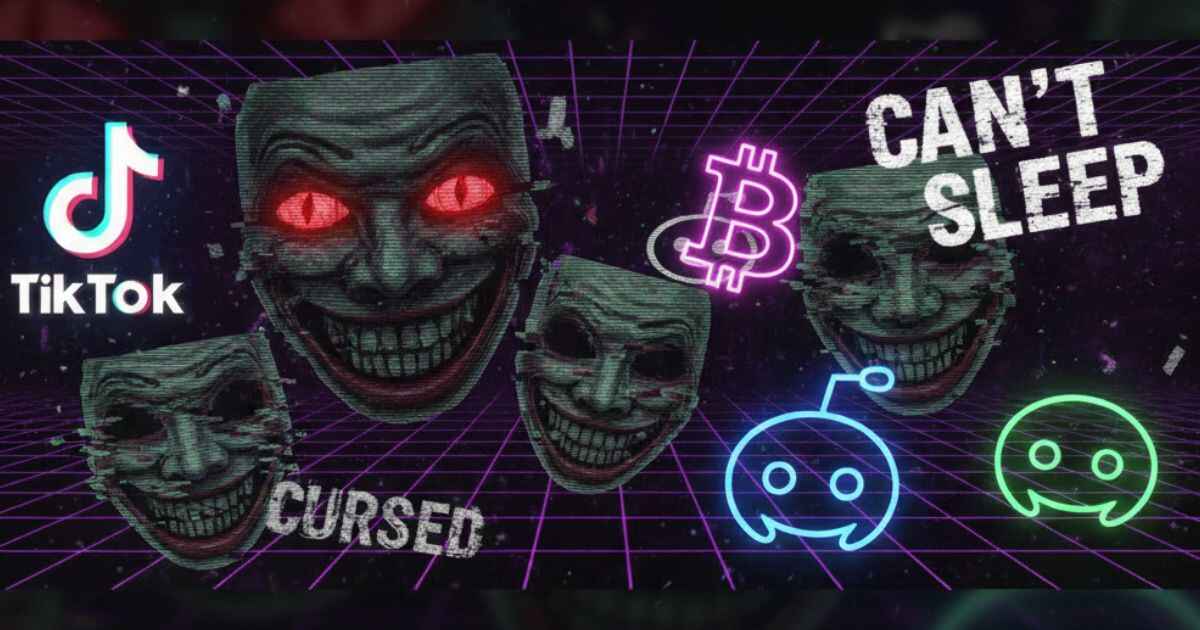
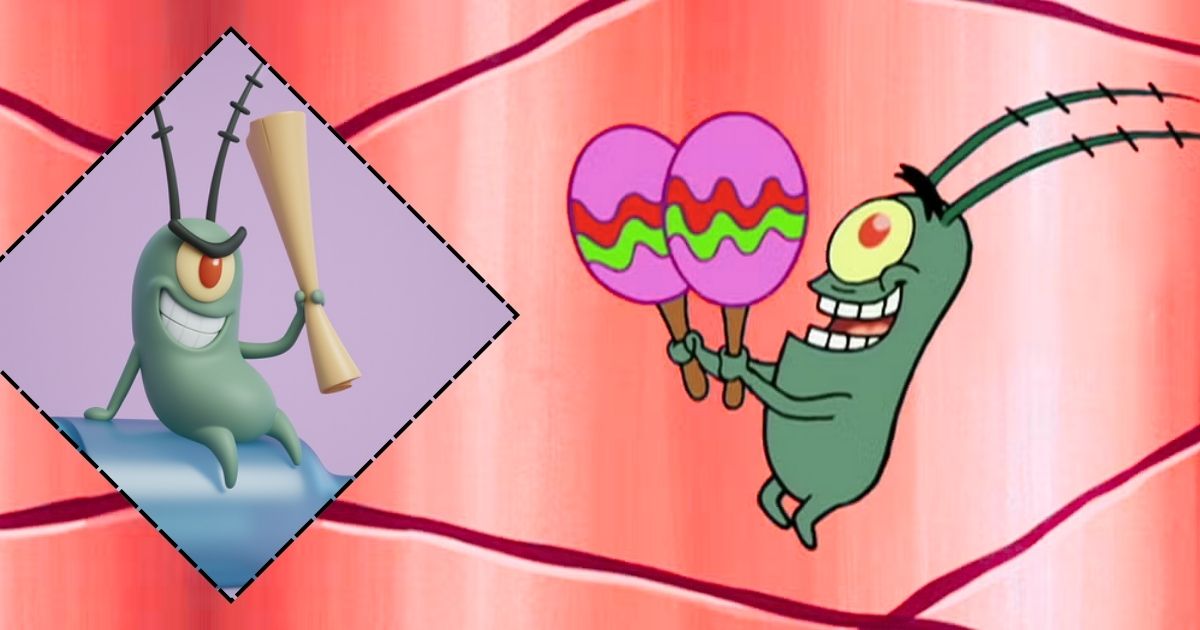
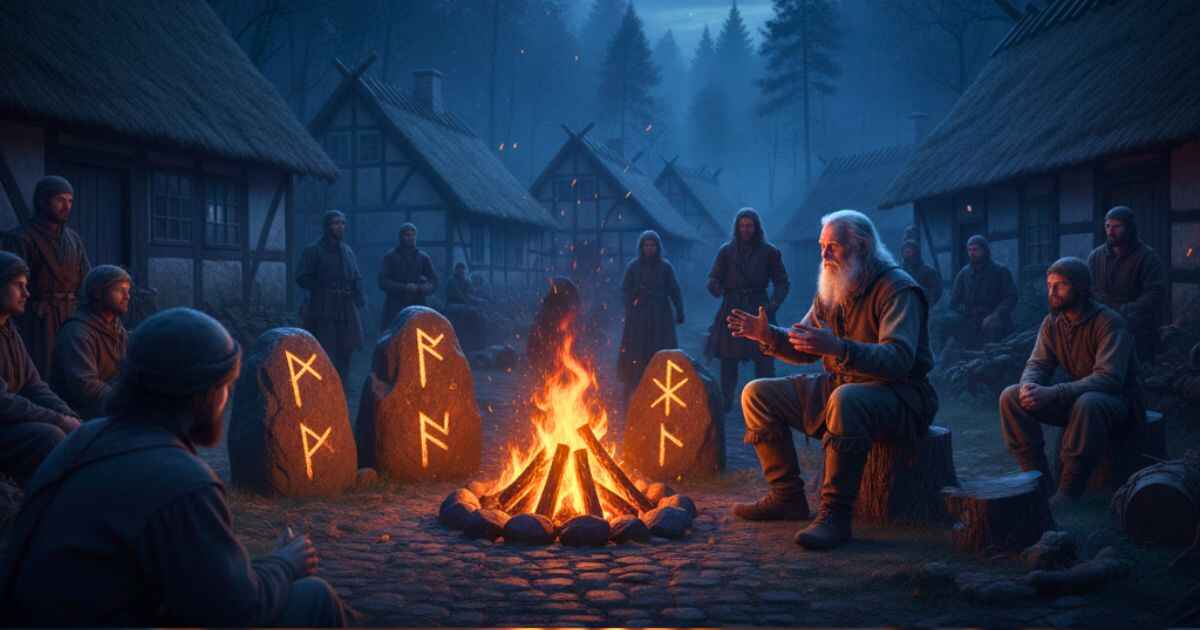
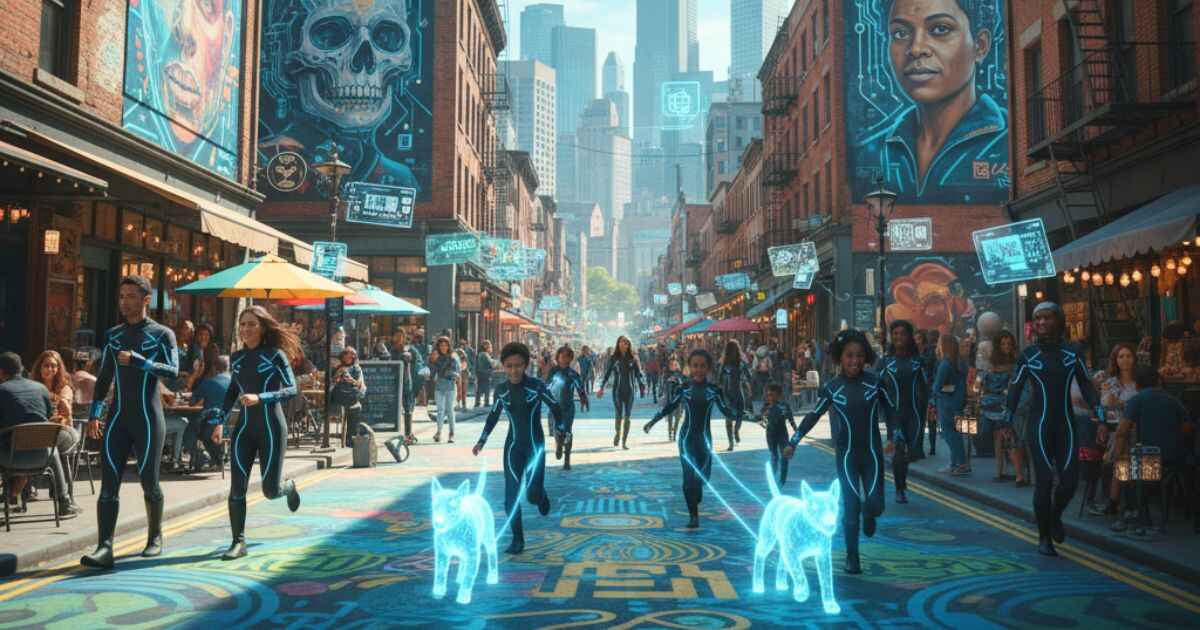

1 thought on “How Horror Memes Shape Digital Culture: Funny or Toxic?”